In the realm of software design and modeling, Unified Modeling Language (UML) serves as a powerful tool for visualizing and documenting the structure and behavior of systems. One of the critical concepts within UML is multiplicity, which defines the constraints on the number of objects that can participate in an association. This article delves into the concept of multiplicity, its significance, and how it is applied in UML diagrams.
What is Multiplicity?
Multiplicity in UML is a constraint that specifies the number of objects that may participate in one end of an association. It answers questions such as “How many Cars may a Person own?” or “How many People can drive a given Car?” By defining multiplicity, you set the rules for how objects in each class may be related, providing a clear and concise way to express these relationships.
Expressing Multiplicity
Multiplicity is typically expressed as a range that defines the minimum and maximum number of objects allowed in an association. The format for expressing multiplicity is:
- Exact Number: A single number indicating the exact count of objects.
- Range: A pair of numbers separated by two dots (..) indicating the minimum and maximum count.
- Asterisk (*): Indicates an unlimited number of objects.
For example:
1: Exactly one object.0..1: Zero or one object.1..*: At least one object, with no upper limit.*: Any number of objects, including zero.
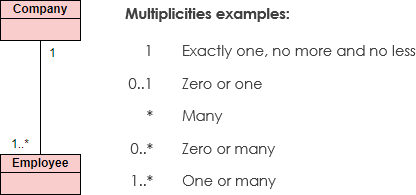
Applying Multiplicity in Associations
When modeling associations between classes, multiplicity is assigned to each end of the association. For instance, consider the association between a Person class and a Car class:
- Question 1: How many Cars may a Person own?
- Question 2: How many People can drive a given Car?
The answers to these questions are placed next to the respective classes in the association. If a Person can own zero to many Cars, the multiplicity near the Car class would be 0..*. Conversely, if a Car can be driven by one to many People, the multiplicity near the Person class would be 1..*.
Example: Shipment and Product
To illustrate, consider a scenario where a Shipment must contain at least one Product but can contain as many Products as needed. The multiplicity for the Product end of the association would be 1..*, indicating that a Shipment must have at least one Product but can have many.
Notation and Symbols
In UML diagrams, multiplicity is denoted using specific notations:
- Asterisk (*): Represents an unlimited number of objects.
- Range (
min..max): Specifies the minimum and maximum number of objects. - Exact Number: Indicates a precise count of objects.
These notations help in clearly defining the constraints and rules governing the relationships between classes.
Example 1: Person and Car
In this example, a Person can own zero to many Cars, and a Car can be driven by one to many People.
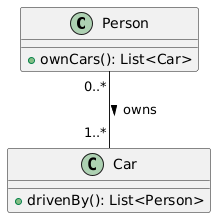
Example 2: Shipment and Product
In this example, a Shipment must contain at least one Product but can contain as many Products as needed.
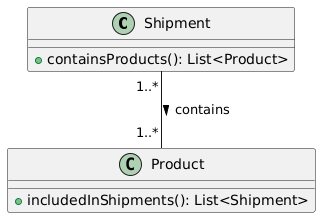
Example 3: Library and Book
In this example, a Library can have many Books, and a Book can be found in one Library.
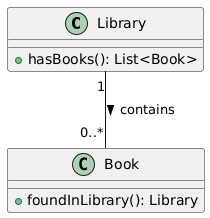
Example 4: Teacher and Student
In this example, a Teacher can teach many Students, and a Student can be taught by one Teacher.
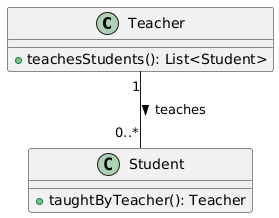
Example 5: Order and Item
In this example, an Order can contain one or more Items, and an Item can be part of zero or more Orders.
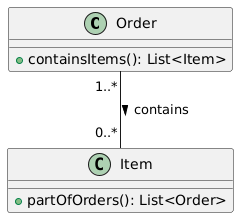
Example 6: Company and Employee
In this example, a Company can have many Employees, and an Employee works for one Company.
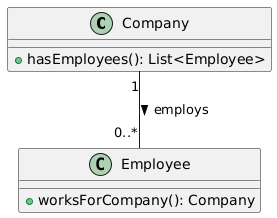
These examples illustrate how multiplicity is used to define the number of objects participating in an association, providing a clear and concise way to express relationships between classes in UML diagrams.
Conclusion
Multiplicity is a fundamental concept in UML that provides a structured way to define the number of objects participating in an association. By specifying multiplicity, designers can ensure that the relationships between classes are well-defined and understood, leading to more robust and maintainable system designs. Whether you are modeling simple associations or complex relationships, understanding and applying multiplicity is essential for effective UML modeling.
Resources
- Drawing Entity Relationship Diagram in Visual Paradigm
- Visual Paradigm. (n.d.). Drawing Entity Relationship Diagram in Visual Paradigm 4.
- Entity Relationship Diagram – Multiplicities
- Stack Overflow. (n.d.). Entity Relationship Diagram – Multiplicities 5.
- Entity Relationship Diagrams
- GitHub. (n.d.). Entity Relationship Diagrams 6.
- Specify multiplicity on an UML shape
- Microsoft Support. (n.d.). Specify multiplicity on an UML shape 7.
- What is Entity Relationship Diagram (ERD)?
- Visual Paradigm. (n.d.). What is Entity Relationship Diagram (ERD)? 8.
- Visual Paradigm ER diagram adding tables
- Stack Overflow. (n.d.). Visual Paradigm ER diagram adding tables 9.
- How do you add a multiplicity to a class diagram in Visual Paradigm?
- TheNewsIndependent. (2020, December 29). How do you add a multiplicity to a class diagram in Visual Paradigm? 10.
- Beginner’s Guide to Entity-Relationship (ER) Diagrams
- Visual Paradigm Blog. (2023, September 21). Beginner’s Guide to Entity-Relationship (ER) Diagrams 11.
- Multiplicity vs Cardinality
- Stack Overflow. (n.d.). Multiplicity vs Cardinality 12.